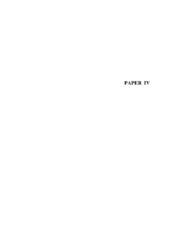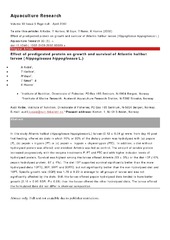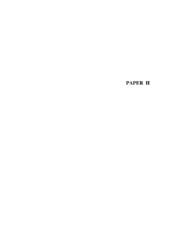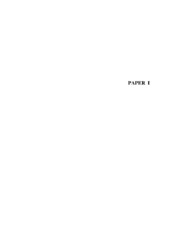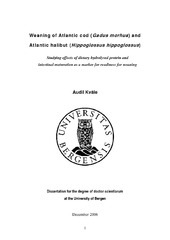| dc.contributor.author | Kvåle, Audil | |
| dc.date.accessioned | 2007-03-05T15:10:12Z | |
| dc.date.available | 2007-03-05T15:10:12Z | |
| dc.date.issued | 2006-12 | eng |
| dc.identifier.isbn | 978-82-308-0319-6 (print version) | eng |
| dc.identifier.uri | https://hdl.handle.net/1956/2128 | |
| dc.description.abstract | The gastrointestinal tract of marine fish larvae undergoes extensive changes during the larval stage. The success in weaning increases as the juvenile stage approaches and the gastrointestinal tract attains a more adult-like form and functionality. In the present study, intestinal maturation in Atlantic cod (Gadus morhua) and Atlantic halibut (Hippoglossus hippolgossus) larvae was compared with weaning studies to give an indication whether intestinal maturation and weaning success were correlated. Activities of the brush border membrane (bbm) enzymes alkaline phosphatase (AP) and leucine aminopeptidase N (LAP) were used as markers for for intestinal maturation. In addition, the activity of intestinal leucylalanine peptidase (Leu-ala) was used as a marker for larval mode of digestion, but this marker gave no information in decline in larval digestive features in cod and halibut. The specific activities of AP and LAP increased abruptly from 30 to 40-50 dpff in both species, corresponding to 50-120 mg wet weight in halibut and 7-9 mm standard length (SL) in cod. These increases mark the time when the intestine achieves a more adult-like functionality, and thus, the fish larvae were considered to be better prepared to digest microparticulate diets. Comparison of intestinal maturation with early weaning studies with cod and halibut indicated that intestinal maturation was important for succeeding in weaning of these two species. However, several factors are supposed to influence the weaning results, and in particular the suitability of the diet. Marine fish larvae absorb hydrolysed protein more efficiently than intact protein. Thus, including part of the dietary protein in a hydrolysed form is thought to enhance growth and development during the larval stage when the gastrointestinal tract is not fully mature. Graded levels of pepsin hydrolysed protein (from 0 to 40-45 %) were included in the weaning diets for cod (11 mg wet weight) and halibut (120 and 220 mg wet weight) in order to define the optimal level of hydrolysed protein. Cod obtained the highest survival rate when 40 % of the dietary protein was exchanged with pepsin hydrolysed protein. Higher inclusion levels were not tested. In contrast, the diets added none or 10 % pepsin hydrolysed protein supported the highest survival rates in halibut. Specific activities of AP and LAP showed positive correlation with the survival results, supporting that cod and halibut took benefit of high and low levels of dietary hydrolysed protein, respectively. Dietary hydrolysed protein did not affect growth significantly. The main reason for the different results obtained with cod and halibut is considered to be a combination of different feeding practise in cod and halibut, and high leaching rates of hydrolysed protein from microparticulate diets. Determination of leaching rates from three microparticulate diets showed that nutrient losses were extensive, but to some extent dependent on type of feed, feed particle size and molecular size of the dietary peptides (i.e. amino acids>hydrolysed protein>intact protein). Halibut ingests diet particles slowly, allowing extensive losses of nutrients from the diet prior to ingestion. Cod ingests diet particles rapidly, and thus when the particles still contain some hydrolysed protein. The protein content in the diets offered to halibut was probably reduced comparatively with hydrolysed protein inclusion level, and since juvenile halibut is considered to have a high dietary protein requirement, a sub-optimal level of protein may have been reached when the diets contained high levels of hydrolysed protein. This may explain the low optimal level of dietary hydrolysed protein to halibut. | en_US |
| dc.format.extent | 366164 bytes | eng |
| dc.format.extent | 126721 bytes | eng |
| dc.format.extent | 189726 bytes | eng |
| dc.format.extent | 31324 bytes | eng |
| dc.format.extent | 149587 bytes | eng |
| dc.format.mimetype | application/pdf | eng |
| dc.format.mimetype | application/pdf | eng |
| dc.format.mimetype | application/pdf | eng |
| dc.format.mimetype | application/pdf | eng |
| dc.format.mimetype | application/pdf | eng |
| dc.language.iso | eng | eng |
| dc.publisher | The University of Bergen | eng |
| dc.publisher | The National Institute of Nutrition and Seafood Research (NIFES) | eng |
| dc.relation.haspart | Paper I: Aquaculture 264 (1-4), Kvåle, Audil; Mangor-Jensen, A.; Moren, M.; Espe, M. & Kristin Hamre, Development and characterisation of some intestinal enzymes in Atlantic cod (Gadus morhua L.) and Atlantic halibut (Hippoglossus hippoglossus L.) larvae, pp. 457-468. Copyright 2006 Elsevier B.V. Reproduced with permission. Submitted version. Full text not available in BORA due to publisher restrictions. The published version is available at: <a href="http://dx.doi.org/10.1016/j.aquaculture.2006.12.024" target="blank"> http://dx.doi.org/10.1016/j.aquaculture.2006.12.024</a> | eng |
| dc.relation.haspart | Paper II: Aquaculture 251(2-4), Kvåle, Audil; Yúfera, M.; Nygård, E.; Aursland, K.; Harboe, T.; & Kristin Hamre, Leaching properties of three different micropaticulate diets and preference of the diets in cod (Gadus morhua L.) larvae, pp. 402-415. Copyright 2005 Elsevier B.V. Reproduced with permission. Published version. The published version is also available at: <a href="http://dx.doi.org/10.1016/j.aquaculture.2005.06.002" target="blank"> http://dx.doi.org/10.1016/j.aquaculture.2005.06.002</a> | eng |
| dc.relation.haspart | Paper III: Aquaculture Research 33(5), Kvåle, Audil; Harboe, T.; Espe, M.; Næss, T.; Hamre, Kristin, Effect of predigested protein on growth and survival of Atlantic halibut larvae (Hippoglossus hippoglossus L.), pp. 311-321. Copyright 2009 Blackwell Publishing. Reproduced with permission. Abstract only. Full text not available in BORA due to publisher restrictions. The published version is available at: <a href="http://dx.doi.org/10.1046/j.1365-2109.2002.00659.x" target="blank"> http://dx.doi.org/10.1046/j.1365-2109.2002.00659.x</a> | eng |
| dc.relation.haspart | Paper IV: Aquaculture Nutrition 15 (2), Kvåle, Audil; Harboe, T.; Mangor-Jensen, A. & Kristin Hamre, Effects of protein hydrolysate in weaning diets for Atlantic cod (Gadus morhua L.) and Atlantic halibut (Hippoglossus hippoglossus L.), pp. 218 – 227. Copyright 2009 Blackwell Publishing. Reproduced with permission. Submitted version. Full text not available in BORA due to publisher restrictions. The published version is available at: <a href="http://dx.doi.org/10.1111/j.1365-2095.2008.00586.x " target="blank"> http://dx.doi.org/10.1111/j.1365-2095.2008.00586.x </a> | eng |
| dc.title | Weaning of Atlantic cod (Gadus morhua) and Atlantic halibut (Hippoglossus hippoglossus). Studying effects of dietary hydrolysed protein and intestinal maturation as a marker for readiness for weaning | eng |
| dc.type | Doctoral thesis | |
| dc.subject.nsi | VDP::Matematikk og Naturvitenskap: 400::Zoologiske og botaniske fag: 480::Marinbiologi: 497 | nob |
